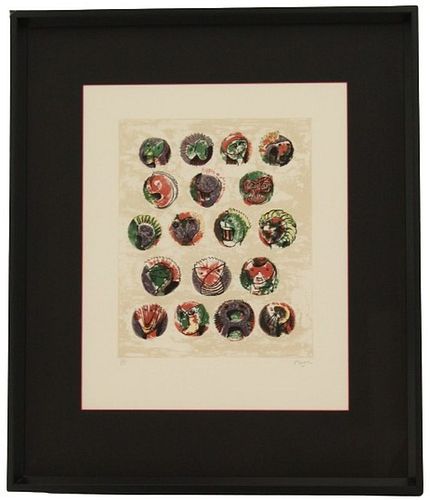Henry Moore (1898-1986) British, Lithograph.
Titled: "Pallas Heads". Artist Signed, Lower Right.
Numbered 25/50, Lower Left.
Features colorful abstract heads in varying shapes and sizes.
Provenance: Sold: Rago, Lambertville NJ, March 2 2022, Lot 380.
Private estate, Sarasota, Florida.
Overall Size: 27 x 23 in.
Sight Size: 18 x 15 in.
Frame Thickness: 1 3/4 in.
#1815
Henry Moore was born in Castleford, a small mining town in Yorkshire, England, in 1898. Moore knew he wanted to be a sculptor from an early age, but reluctantly trained as a teacher before joining the army during the First World War.
In 1919, thanks to an ex-servicemen's grant, he realized his ambition to become an artist. He enrolled first at Leeds School of Art, and then the Royal College of Art in London. There, Moore met Irina Radetsky, whom he married in 1929.
In the 1920s, Moore focused on establishing his reputation as a sculptor. He studied the art of the past and of his contemporaries, absorbing ideas as he developed his own individual style. By the 1930s he was among the leading avant-garde sculptors of Europe.
In 1939 war broke out again. In 1940, Moore began drawing people sheltering in the London Underground during the Blitz. Moore’s ‘Shelter Drawings’ captured the popular imagination, recognised as a sensitive yet powerful response to the War. Moore was asked to make further drawings, and became an official war artist.
In the same year, Moore’s own home in Hampstead, London, was damaged by bombing. He and Irina moved to Perry Green, in Hertfordshire. Hoglands, the farmhouse they had rented temporarily, became home for the rest of their lives.
It was here their daughter Mary was born in 1946. Gradually, they developed outbuildings into studios, and rough areas of chicken runs and vegetable patches became gardens for displaying sculpture.
During the War, circumstances forced Moore to concentrate on drawing. However, in 1943 he was commissioned to carve a Madonna and Child for the Church of St. Matthew in Northampton.
This sculpture was the first of several Moore made in the immediate aftermath of the War. They focused on recognisable human subjects (much like his shelter drawings), such as seated figures and family groups.
In Britain, art was made integral to the rehabilitation and reconstruction of the country. Moore commented repeatedly on the civic responsibility of the artist. In the late 1940s and 1950s he made a remarkable sequence of public works, sited in schools, hospitals, and housing estates.
Moore’s international reputation also grew. Exhibitions of his work were held around the world including a major retrospective at the Museum of Modern Art, New York, in 1946. In 1948, he won the International Prize for Sculpture at the Venice Biennale.
Several important public commissions followed in the 1950s, among them Reclining Figure 1956-58, for the UNESCO headquarters in Paris. By 1960 Moore was arguably at the height of his powers.
In a decade characterized by social and cultural change, Moore was driven to create progressively abstract works inspired by nature, on an increasingly large scale.
Moore explored the body-landscape metaphor in a monumental multi-part figure for the Lincoln Center for Performing Arts in New York, installed in 1965. This Reclining Figure is sited in a pool, and appears to rise out of the water like cliffs.
Moore’s investigation of organic forms also inspired sculptures with knife-sharp edges, compact twisted forms and stretching points.
While new types of sculpture started to compete for attention with Moore’s bronzes, international demand for his work continued to grow.
Moore featured regularly in the press, on television, and worked closely with a number of photographers. Numerous new publications on his life and work were produced in the 1960s and 1970s.
This, combined with major exhibitions – such as Tate in London, 1968 and the Forte di Belvedere in Florence, 1972 – secured his widespread fame. Location S1
Available payment options
We accept all major credit cards, wire transfers, money orders, checks and PayPal. Please give us a call at (941) 359-8700 or email us at SarasotaEstateAuction@gmail.com should you have any questions about payment.












